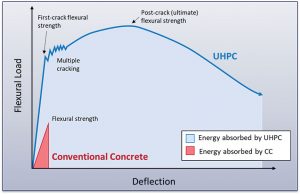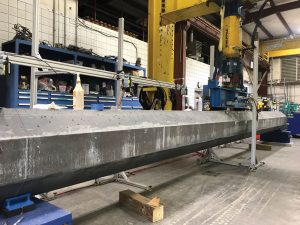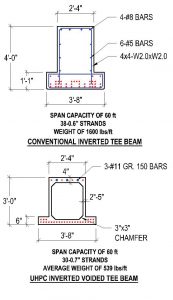A Game Changer
Ultra-high-performance concrete (UHPC) was first introduced as reactive powder concrete (RPC) in the early 1990s by employees of the French contractor Bouygues. When introduced, it came in two classes: Class 200 MPa (29 ksi) and 800 MPa (116 ksi). In the U.S., several state departments of transportation have expressed interest in introducing UHPC in their bridge projects, supported by Federal Highway Administration (FHWA) research as well as research done by universities. Most notably, Virginia has produced I-beams with UHPC and Iowa has built two bridges with UHPC beams and one with a UHPC deck. Significant interest has recently been directed at using UHPC in longitudinal joints between precast concrete beams. Use of UHPC in bridges has increased in applications in the U.S. primarily due to leadership by the FHWA.
Lafarge Cement Company markets a trade-named, pre-bagged UHPC product called Ductal®, formulated based on the work of the RPC invented by Bouygues. However, its high cost has discouraged owners from implementing the use of this outstanding material in applications beyond initial demonstration projects, many of which had been subsidized by government technology implementation programs.
Recently, several state highway agencies, in collaboration with local universities, have produced concrete mixtures that are much less expensive than the original RPC and Ductal materials. In addition, the Precast/Prestressed Concrete Institute (PCI) has recently commissioned the authors, in partnership with others, to undertake a large UHPC implementation project in which six major precast concrete companies are collaborating to develop their own UHPC mixture proportions and to implement the technology in long precast pretensioned concrete beams for bridges, parking structures, office buildings, and residential buildings. The three-year program will culminate in guidelines for precasters, designers, and owners. The project is believed to be the first of its kind, as it will result in recommendations for design and production of precast, pretensioned beams as long as 250 feet.
What is UHPC?
According to FHWA, “UHPC-class materials are cementitious based composite materials with discontinuous fiber reinforcement, compressive strengths above 21.7 ksi, tensile strengths above 0.72 ksi, and enhanced durability via their discontinuous pore structure.” However, this definition is not universally used. The Canadian Standards Association (CSA) includes two categories of UHPC: 120 MPa (17.4 ksi) and 150 MPa (21.7 ksi). The PCI research project specifies compressive strength of 10 ksi (at prestress release) and 18 ksi (at 28 days). The most significant property for structural design using UHPC is the tensile strength and tensile ductility, which are much higher in UHPC due to the presence of steel fibers, compared to conventional concrete. In the PCI research project, it is recommended that the ASTM C1609-determined flexural strength is above 1.5 ksi at first cracking and above 2 ksi at peak value with a significant deflection (ductility) beyond cracking (Figure 1). This high strength allows for much higher shear resistance and the possibility of total elimination of shear reinforcing bars.
The ingredients in UHPC vary. In general, the mixture consists of about 1200 lb/yd3 of portland cement; 250 lb/yd3 of silica fume; 250 lb/yd3 of supplementary cementitious material such as fly ash, ground slag, or silica powder; and 1700 lb/yd3 of fine sand with a maximum grain size of 0.03 inch. The materials are proportioned to produce the highest particle packing density. This, along with a very low water-cementitious materials ratio of 0.16 to 0.20, is the primary source of UHPC’s high compressive strength. The material is highly flowable with the aid of special admixtures. The addition of special steel fibers in the amount of about 2 percent by volume, about 265 lb/yd3, cause UHPC’s high tensile strength and ductility. The fibers are cut from very fine 360 ksi brass coated steel wire. Figure 2 shows an example of the individual materials being used in UHPC.
Use of UHPC
Pre-bagged UHPC has been selling for over $2000 per cubic yard. Also, fibers cost between $250 and $500 per cubic yard depending on dosage and source of fibers. It is therefore sometimes difficult to justify using materials that cost nearly $3000 per cubic yard. This is why UHPC usage has been limited to joints, where low volume use, although expensive, does not significantly affect the total cost of the project.
Several precasters, under the sponsorship of PCI, are in the process of developing their own mixture proportions resulting in a total materials cost of about $600 to $800 per cubic yard. This lower cost has the potential of making UHPC competitive on a first-cost basis, in addition to the benefit of achieving outstanding durability characteristics of the resulting structures. Trial designs have demonstrated the possibility of saving about 50 percent of the concrete volume, weight, and other associated benefits: savings in shipping, erection, foundation, temporary supports, etc. Conventional precast/prestressed concrete bridge beams sell on average nationally for about $750 per cubic yard. If only 50 percent of the volume is used with UHPC, the price per cubic yard can double to $1500 without exceeding the conventional concrete cost. The additional $750 would be more than adequate to cover the cost of production and to allow for some extra risk in using a relatively new material.
Several additional hurdles must be overcome for commercial production of large-scale precast, prestressed concrete members. For example, mixing time and concrete delivery to precasting molds must allow quantities as large as 75 cubic yards for a single member without risking the creation of cold joints. Also, structural engineers and architects are being challenged to step forward with creative solutions for full utilization of this special material.
An effort is urgently needed to publish a design guide for both building and bridge products and systems. Again, several attempts are currently underway by FHWA and PCI to produce such documents. Several countries such as Australia, France, Japan, Switzerland, and, most recently, Canada have already published similar recommendations, which will prove to be helpful as U.S. codes and standards are updated to allow for this exciting material.
Structural Design Considerations
In the U.S., structural design criteria for UHPC have not been fully developed. However, enough knowledge exists to perform conservative designs until refinements are published. For a beam element, service-load flexural design can be performed using linear elastic theory with the relevant material properties and with prestress losses assumed to be 10% and 20% at initial and final conditions, respectively, and with tensile stress limit assumed equal to 50% of the flexural strength of UHPC. Prestressing is still the primary tension resistance element.
A significant beneficiary of UHPC is shear resistance. It is conservative to assume that the fibers contribute about 1000 psi of shear strength resistance. Considering that concrete resistance, Vc, is on the order of 100 to 400 psi and conventional mild-steel reinforcement resistance is capped at about 800 psi, it is easy to see that shear rebar reinforcement may not be necessary for many applications. Long-term camber is not much different from initial camber, as creep is a small fraction of that in conventional concrete. Live load deflection can be a critical design parameter due to reduced inertia associated with relatively small cross sections. It is advisable to not reduce the depth of a conventional member in the optimization process without carefully assessing live load deflections.
Example Applications
The following describes several concepts being pursued for development of UHPC precast/prestressed products.
Piles
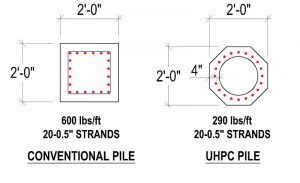
Figure 3. Comparison of conventional concrete pile with UHPC pile of the same flexural capacity. Note, UHPC has higher compressive capacity and better resistance to pile driving effects.
Figure 3 shows a standard Florida Department of Transportation (FDOT) pile that is 24 inches square and prestressed with twenty ½-inch-diameter special strands and an equivalent UHPC pile. The conversion is made by blocking out the corners and creating an internal stay-in-place cardboard tube void. The result is over 50% reduction in weight while the flexural capacity remains essentially the same and the axial capacity is significantly increased. Note that the spirals generally required for conventional concrete may be found to be unnecessary due to the presence of high tensile strength fibers. Pile driving may prove to be less risky due to the material toughness and ability to absorb energy. Figure 4 shows a pile segment, made by Standard Concrete Products (SCP) of Tampa, being tested in the structural laboratory of FDOT.
Decked Bridge I-Beams
Figure 5 shows a conventional bridge system, using an NU (Nebraska University) girder. Eight-foot-deep beams spaced 9 feet apart with a composite cast-in-place deck can span up to 180 feet. A UHPC-decked I-beam system with the same total superstructure depth and spacing would have a maximum possible span of 265 feet while using a fraction of the total concrete volume. Also, it may be possible to eliminate all shear reinforcement, thus greatly simplifying production.
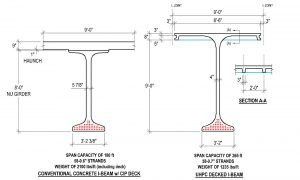
Figure 5. Conventional concrete versus UHPC bridge I-beam. It is possible to increase span capacity while reducing the unit weight. Also, shear reinforcement can be eliminated.
Inverted Tee Beams for Parking Structures
Figure 6 shows a comparison between a recently used inverted tee beam, designed by the Consulting Engineering Group, San Antonio, TX. The beam was required to span 60 feet and to support double tees that also span 60 feet in the perpendicular direction. The UHPC voided inverted-tee beam shown was based on a preliminary design by the authors. It has the potential of being one foot shallower and 65 percent lighter. Note that the web width is expected to gradually increase from 2 inches in the middle third of the beam to 5 inches at the ends. This can be accomplished by varying the expanded polystyrene void form width. With this design, it is possible to eliminate all shear and torsion rebar and to count on the fibers for resistance to these forces.
Observation Tower
Figure 7 illustrates an interesting structure being designed for the owner of SCP who is a racehorse fan and who holds an annual charity event for horse racing on his property. He is convinced of the value of UHPC and wants to demonstrate its use by building a precast UHPC tower on his property. The preliminary design of the tower is reflected in Figure 7. Only two types of UHPC elements are used: an octagonal 36-inch hollow pile and 1⁄8th disc floor segments. Eight segments per floor times three floors = 24 identical segments, each requiring less than one cubic yard of UHPC as the floor is only 2 inches thick.
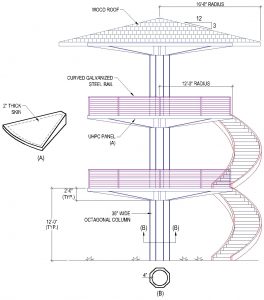
Figure 7. Observation tower for horse racing made of precast UHPC elements, except the roofing, railings, and stairs.
Conclusion
UHPC is expected to reach a new level in practice in the next 5 to 10 years. An effort is underway that will allow the material to be economically competitive with conventional concrete on a first cost basis. Life cycle cost will be much more attractive due to the very high durability of this material. Design guidelines for structural design are being developed for possible inclusion in both bridge and building codes and standards. The efforts led by PCI and FHWA are expected to result in fully developed design examples for buildings and bridges. Using UHPC, it will be possible to design a precast concrete multi-story building with 60- by 60-foot column-free bays and to design bridges with spans well beyond the current limits on precast prestressed concrete of 180 to 200 feet.■
References
Graybeal, Ben. 2014. Design and Construction of Field-Cast UHPC Connections. Publication No. FHWA-HRT-14-084. National Technical Information Service, McLean, Virginia, USA.11-16.
Richard, P., and Cheyrezy, M.H. 1994. Reactive Powder Concretes with High Ductility and 200-800 MPa Compressive Strength, ACI, SP-144(24), San Francisco, California, USA, 507-518.
Tadros, M. K., and Morcous, G. 2009. Application of Ultra-High Performance Concrete to Bridge Girders. Nebraska Department of Roads (NDOR) Project Number P310, Lincoln, NE, USA, 72.
Voo, Y. L., Foster, S. J., and Hassan, M. F. 2014. The Current State of Art of Ultra-High Performance Concrete Bridge Construction in Malaysia, Proceedings of the 12th International Conference on Concrete Engineering and Technology. 12-14 Aug, Selangor, Malaysia, 95-102.
Wille, K., Naaman, A.E., and El-Tawil, S. 2011. Optimizing Ultra-High-Performance Fiber- Reinforced Concrete. Concrete International, 33(9): 35–41.

